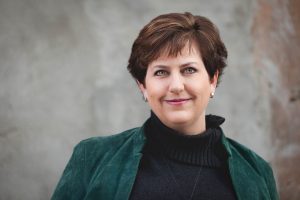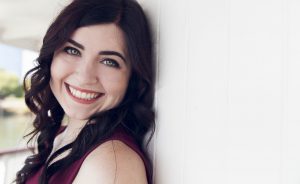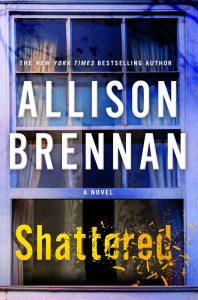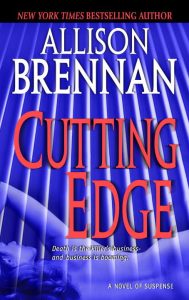 New York Times and USA Today bestselling author Allison Brennan believes life’s too short to be bored, so she had five kids and writes three books a year. She’s currently writing two series–the Lucy Kincaid thriller series about an FBI agent who believes the rules are there for a reason, and the Maxine Revere cold case mystery series about an investigative reporter who believes the rules are meant to be broken.
New York Times and USA Today bestselling author Allison Brennan believes life’s too short to be bored, so she had five kids and writes three books a year. She’s currently writing two series–the Lucy Kincaid thriller series about an FBI agent who believes the rules are there for a reason, and the Maxine Revere cold case mystery series about an investigative reporter who believes the rules are meant to be broken.
Her upcoming release SHATTERED brings her two series characters together for the first time.
Allison lives in Northern California with her family and assorted pets.
 Kelly Brennan is an Interdisciplinary Studies major emphasizing in English and Graphic Design at Southern Oregon University.
Kelly Brennan is an Interdisciplinary Studies major emphasizing in English and Graphic Design at Southern Oregon University.
KB: How did you decide to make a career in writing?
AB: I’ve always wanted to be a writer. When I was 13, I read THE STAND by Stephen King and wrote him a fan letter. I told him I wanted to be a writer “when I grew up.” He sent me back a post card that said, “If you want to be a writer, write.” It took me years before I understood what he meant.
Life happened. I dropped out of college and got a job in the California State Legislature. I got married, had kids, had a career. After my son was born in 2001, I reflected that I was over 30, unhappy in my job and dissatisfied with my life. I read 77 books (all fiction) while on maternity leave and remembered my dream of being a writer. Two books in particular inspired me – THE THIRD VICTIM by Lisa Gardner and THE SEARCH by Iris Johansen. I gave up television for three years and wrote every night from nine until midnight. It took mey five manuscripts before I found an agent who then sold my book in a three-book deal. I quit my day job and never looked back.
KB: You’ve written thirty books in several series—how do you keep all the series and characters straight?
AB: Short answer: I don’t. I’ve made several mistakes over the course of my longest running series (the Lucy Kincaid series now with 12 books.) I’ve inadvertently changed minor details in the physical description of my characters (Lucy’s brother has had three different eye colors!) and another minor character started out as a Marine vet and is now an Army vet.
I wish I had kept a “book bible” as one of my writer friends calls it. Essentially, a journal of all characters and basic physical description and backstory. I don’t mess up my main characters – they feel very real to me, so even if I don’t mention something, I already know it. But the minor characters? Yes, I’ve made mistakes.
Recently, I finished writing SHATTERED (on sale August 22, 2017) which is a cross-over book starring my two series main characters. Before I wrote it, I re-read several scenes from previous books to make sure that I got certain details right. This was crucial because the book is about the twenty-year-old cold case murder of Lucy Kincaid’s nephew when he (and Lucy) were only seven. I knew readers would remember the details because it was a turning point in Lucy’s life, so I had to make sure that I didn’t get something wrong.
 KB: Is there a theme that runs through all your work? Justice, perhaps?
KB: Is there a theme that runs through all your work? Justice, perhaps?
AB: Yes, probably justice. I don’t write with a specific theme in mind, but my books always have a happy (or bittersweet) ending. I think in life we often see that justice isn’t served. That the bad guys get away with awful crimes and innocent people suffer. While people suffer in my books (otherwise I wouldn’t be writing crime fiction!), the bad guy always gets what’s coming to him. My mother pointed out that I kill off all my bad guys at the end of the book. That’s not completely true … but it’s mostly true. 🙂
Another theme that shows up in most of my books is the idea that we’re not an island. My main character often feels that they are the only person who cares about solving a specific crime, or that they can do it by themselves. Over the course of the story, they realize that they are not the only person that cares, and that sometimes they need the help of others to save the day – that asking for help is not a crime.
KB: You seem to have a lot of fun writing, sometimes even putting real people in the books. Tell us about that.
AB: Yes, I love writing. Doing what you love as a way to earn a living? There’s nothing better.
I don’t put real people in books per se, but there have been times I’ve used people’s names. I’ve done a lot of charity fundraisers (for example, the Sacramento County Friends of the Library) where patrons will pay a lot of money to have their name in a book. I don’t use anything about them, just their name, and they have to sign a disclaimer. For example, one person became an underage prostitute; another became a cop; and friends of the family became victims of a serial killer.
 I did, however, use traits of my brother-in-law Kevin Brennan as the basis of creating my serial killer in THE HUNT. I interviewed Kevin as research – he’s a wildlife biologist, and my killer was a wildlife biologist. He helped me make my bad guy very realistic, and gave me some great technical and geographic information that helped my good guys identify and stop the killer. Kevin also helped with my book CUTTING EDGE that started with research ducks being released by eco-terrorists, ultimately threatening an entire species.
I did, however, use traits of my brother-in-law Kevin Brennan as the basis of creating my serial killer in THE HUNT. I interviewed Kevin as research – he’s a wildlife biologist, and my killer was a wildlife biologist. He helped me make my bad guy very realistic, and gave me some great technical and geographic information that helped my good guys identify and stop the killer. Kevin also helped with my book CUTTING EDGE that started with research ducks being released by eco-terrorists, ultimately threatening an entire species.
KB: What sort of research goes into the books? Do you have FBI or police consultants?
AB: I love research. Other than the actual writing, research is my favorite part of writing!
I extensively research for all my books. I learned the hard way in one of my earliest novels that getting the details right is important not just for me, but for reader enjoyment. (I got a medical detail wrong and several nurses emailed me about the same error.) I have several friends who are in all areas of law enforcement who I can call upon at any time, which is my primary source of information. I have a library of more than fifty books about crime, the criminal justice system, forensics, and criminal psychology. I’ve toured the morgue, viewed an autopsy, been on ride-alongs with local law enforcement, participated in the FBI citizens academy, have been a role player in numerous FBI-SWAT training exercises, and participated in the Writer’s Police Academy where I was invited to speak about how to research when you’re not an expert on anything.
While researching STALKED, for example, I visited the FBI Academy at Quantico and toured the facility. This was my second trip east for research purposes. I was able to walk around the campus, question the media representative, talk to some of the recruits and trainers, watch drills, and learn as much as possible about what it’s like to be an FBI Agent-in-Training without actually going through the process. All this helped immensely in writing a story about a murder at Quantico.
One of my favorite research books is BOOK OF POISONS put out in the “Howdunit” series by Writers Digest. I’ve used it extensively, and recently have been perusing it to find the perfect weapon to kill someone slowly.
KB: What do you enjoy most about writing, or about being a writer?
AB: This is a surprisingly difficult question to answer. It would be easy to say, “I love writing” because it’s true, but that’s not really an answer. I love creating a story filled with characters that readers can believe—at least for a short time—actually exist. My favorite fan letters and reviews will say that I kept them up until the wee hours of the morning. That makes me feel like I’ve done my job – that I’ve given someone a reason to keep reading past their bedtime.
KB: What’s the worst part of being a writer?
AB: Sometimes, the stress of life makes writing next to impossible. Whether it’s worries about finances, or health, or my kids – if I have a major issue to deal with, creativity takes a backseat. When I have a deadline, this is doubly stressful because I know I HAVE to write to meet my deadline, but the situation makes it impossible to focus and create. Anytime you make your living through the creative arts, outside pressure can have a devastating affect on the end product. I think this is why many creative people develop chemical dependancy (drugs or alcohol) because sometimes to push aside the personal conflicts the creative person uses artifical solutions. In the short term it works. In the long term, it creates even more problems.
KB: How do you juggle five kids while writing full time?
AB: I have worked full-time since I was 20 years old and dropped out of college. There are many working mothers out there – women who work 9-to-5 or more—in order to provide for their family. Writing is my job – it’s how I make my living. And while in some ways it is more demanding and stressful than when I was working 9-to-5 in the Legislature, I have more flexibility. I can, for example, take a few hours off to go on a field trip or drive a kid to practice. I make up the writing time at night or early in the morning.
I would much rather have flexibility than to be stuck in one cubicle for eight hours straight.
KB: What is the editorial process like for you? What kind of feedback is most helpful?
AB: I have been blessed with great editors.
My first editor, Charlotte, taught me the most – she taught me how to self-edit and how to recognize story flaws. She made me a better writer. I’m with a different publisher, but the editorial process is similar: I write a good book. My editor reads the book and asks questions about the character and story that help me revise my book into something much, much better.
The editorial process is not really a simple process. To create a book worth publishing, I go through several steps:
-
1) I write the first draft. This is my “sloppy copy” – because I don’t plot, this is basically a rough draft that I also keep notes in. Meaning, if I don’t think something is working I might write notes to myself to look at certain scenes or threads.
2) My rewrite. Though I edit as I write, when I get to “the end” I will go back to the beginning and do a more thorough edit/rewrite and address any major story problems I can see.
3) I send this next draft to my editor. She sends me notes, sometimes with the manuscript attached, and I then revise the entire book.
4) Copyedits. Most of the time, I only go through one round of editor revisions before the book goes to copyedits. This is the stage where the copyeditor conforms the book to house style, identifies any grammatical issues, and queries potential plot problems. (For example, in my first novel I had a character exit the same scene twice!) I get to review the copyedits and make any additional changes. I might tweak the book a bit – word choices, trimming repetition, etc. I might add/delete a scene but not any major revisions.
5) Page Proofs/Galleys. The revised copyedits go back to my publisher to be set for print. I get a set of proofs before they go to print. This is where I look for minor errors (mostly in typesetting) or tweak content to make it as strong as it can be.
KB: What are your favorite books/writers? Who inspires you the most?
AB: I read a lot of mysteries growing up. I was born in 1969 … we didn’t have a Young Adult genre. The YA section was a mere shelf in the library. I started with Encyclopedia Brown and moved on to Trixie Belden then Two-Minute Mysteries and Nancy Drew and then my mother’s Agatha Christie collection. When I was 13 I read THE STAND, my first Stephen King novel, and never looked back. King is the master of character and suspense … few have come even close.
As an adult, I’m most inspired by Lisa Gardner, J.D. Robb, Michael Connelly, Lee Child, and Ray Bradbury. FAHRENHEIT 451 is still one of my all-time favorite books. Though I write crime fiction that focuses on the thriller elements of writing, my dream is to write a utopian/dystopian series. I have always been drawn to the “what ifs” in the world around me.
KB: What advice do you have for aspiring writers?
AB: My advice changes with my mood. The first bit of advice? Write what you love. Never write to trends because by the time you’re done, the trend will have passed.

 Follow
Follow